|
Search, browse, and study this dictionary to learn more about the early American, Christian language. 
 1828.mshaffer.com › Word [angle]
1828.mshaffer.com › Word [angle]
AN'GLE, n. [L. angulus, a corner. Gr.] In popular language, the point where two lines meet, or the meeting of two lines in a point; a corner.In geometry, the space comprised between two straight lines that meet in a point, or between two straight converging lines which, if extended, would meet; or the quantity by which two straight lines, departing from a point, diverge from each other. The point of meeting is the vertex of the angle, and the lines, containing the angle, are its sides or legs.In optics, the angle of incidence is the angle which a ray of light makes with a perpendicular to the surface, or to that point of the surface on which it falls.The angle of refraction is the angle which a ray of light refracted makes with the surface of the refracting medium; or rather with a perpendicular to that point of the surface on which it falls.A right angle, is one formed by a right line falling on another perpendicularly, or an angle of 90 degrees, making the quarter of a circle.An obtuse angle is greater than a right angle, or more than 90 degrees.A rectilineal or right-lined angle, is formed by two right lines.A curvilineal angle, is formed by two curved lines.A mixed angle is formed by a right line with a curved line.Adjacent or contiguous angles are such as have one leg common to both angles, and both together are equal to two right angles.External angles are angles of any right-lined figure without it, when the sides are produced or lengthened.Internal angles are those which are within any right-lined figure.Oblique angles are either acute or obtuse, in opposition to right angles.A solid angle is the meeting of three or more plain angles at one point.A spherical angle is one made by the meeting of two arches of great circles, which mutually cut one another on the surface of the globe or sphere.AN'GLE, n. A hook; an instrument to take fish, consisting of a rod, a line and a hook, or a line and hook. AN'GLE, v.i. 1. To fish with an angle, or with line and hook.2. v.t. or i. To fish for; to try to gain by some bait or insinuation, as men angle for fish; as, to angle for the hearts of people, or to angle hearts.
|
Evolution (or devolution) of this word [angle]
| 1828 Webster | 1844 Webster | 1913 Webster |
|---|
AN'GLE, n. [L. angulus, a corner. Gr.] In popular language, the point where two lines meet, or the meeting of two lines in a point; a corner.In geometry, the space comprised between two straight lines that meet in a point, or between two straight converging lines which, if extended, would meet; or the quantity by which two straight lines, departing from a point, diverge from each other. The point of meeting is the vertex of the angle, and the lines, containing the angle, are its sides or legs.In optics, the angle of incidence is the angle which a ray of light makes with a perpendicular to the surface, or to that point of the surface on which it falls.The angle of refraction is the angle which a ray of light refracted makes with the surface of the refracting medium; or rather with a perpendicular to that point of the surface on which it falls.A right angle, is one formed by a right line falling on another perpendicularly, or an angle of 90 degrees, making the quarter of a circle.An obtuse angle is greater than a right angle, or more than 90 degrees.A rectilineal or right-lined angle, is formed by two right lines.A curvilineal angle, is formed by two curved lines.A mixed angle is formed by a right line with a curved line.Adjacent or contiguous angles are such as have one leg common to both angles, and both together are equal to two right angles.External angles are angles of any right-lined figure without it, when the sides are produced or lengthened.Internal angles are those which are within any right-lined figure.Oblique angles are either acute or obtuse, in opposition to right angles.A solid angle is the meeting of three or more plain angles at one point.A spherical angle is one made by the meeting of two arches of great circles, which mutually cut one another on the surface of the globe or sphere.AN'GLE, n. A hook; an instrument to take fish, consisting of a rod, a line and a hook, or a line and hook. AN'GLE, v.i. 1. To fish with an angle, or with line and hook.2. v.t. or i. To fish for; to try to gain by some bait or insinuation, as men angle for fish; as, to angle for the hearts of people, or to angle hearts. |
AN'GLE, n.A hook; an instrument to take fish, consisting of a rod, a line and a hook, or a line and hook.
AN'GLE, n. [Fr. angle; L. angulus, a corner; Gr. αγκυλος, W. ongle; G. and D. angel, a hook, an angle; Dan. angel, a hook, angle, a sting; Sax. angel, a hook; Sp. and Port. angulo; It. angolo. The German has angeln, for angling to with a hook; but in D. hengel is the rod, and hengelen, to angle. Qu. hinge and hang.]In popular language, the point where two lines meet or the meeting of two lines in a point; a corner.
In geometry, the space comprised between two straight lines that meet in a point, or between two straight converging lines which, if extended, would meet; or the quantity by which two straight lines, departing from a point, diverge from each other. The point of meeting is the vertex of the angle, and the lines, containing the angle, are its sides or legs.
In optics, the angle of incidence is the angle which a ray of light makes with a perpendicular to the surface, or to that point of the surface on which it falls.
The angle of refraction is the angle which a ray of light refracted makes with the surface of the refracting medium; or rather with a perpendicular to that point of the surface on which it falls. – Encyc.
A right angle is one formed by a right line falling on another perpendicularly, or an angle of 90 degrees, making the quarter of a circle.
An obtuse angle is greater than a right angle, or more than 90 degrees.
An acute angle is less than a right angle, or less than 90 degrees.
A rectilineal or right-lined angle is formed by two right lines.
A curvilineal angle is formed by two curved lines.
A mixed angle is formed by a right line with a curved line.
Adjacent or contiguous angles are such as have one leg common to both angles, and both together are equal to two right angles.
External angles are angles of any right-lined figure without it, when the sides are produced or lengthened.
Internal angles are those which are within any right-lined figure.
Oblique angles are either acute or obtuse, in opposition to right angles.
A solid angle is the meeting of three or more plane angles at one point.
A spherical angle is one made by the meeting of two arches of great circles, which mutually cut one another on the surface of the globe or sphere. – Bailey.
AN'GLE, v.i.- To fish with an angle, or with line and hook.
- v. t. or vi. To fish for; to try to gain by some bait or insinuation, as men angle for fish; as, to angle for the hearts of; people, or to angle hearts. – Shak. Sidney.
|
An"gle
- The inclosed space near the point
where two lines meet; a corner; a nook.
- To fish with an angle
(fishhook), or with hook and line.
- To try to gain by some
insinuating artifice; to allure.
- The figure
made by. two lines which meet.
|
| 1828 Webster | 1844 Webster | 1913 Webster |
|---|
Thank you for visiting!
- Our goal is to try and improve the quality of the digital form of this dictionary being historically true and accurate to the first American dictionary. Read more ...
- Below you will find three sketches from a talented artist and friend depicting Noah Webster at work. Please tell us what you think.
Divine Study
 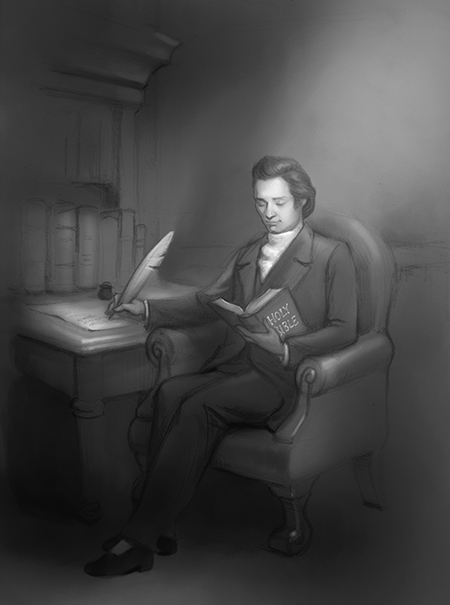
Divine Study
|
Window of Reflection
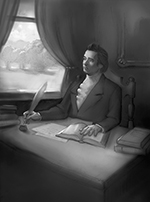 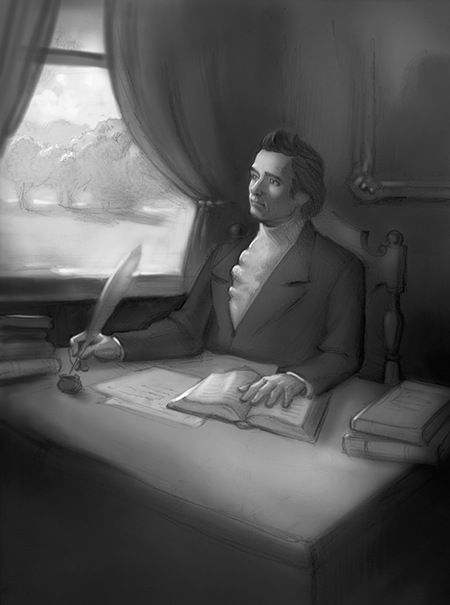
Window of Reflection
|
Enlightening Grace
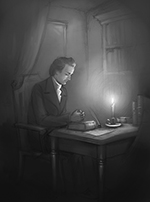 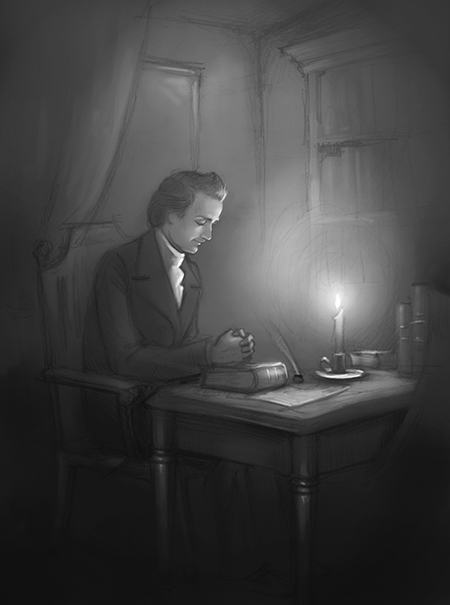
Enlightening Grace
|
160
|
937 |
113
|
1020 |
186
|
1053 |

Angle AN'GLE, noun [Latin angulus, a corner. Gr.] In popular language, the point where two lines meet, or the meeting of two lines in a point; a corner. In geometry, the space comprised between two straight lines that meet in a point, or between two straight converging lines which, if extended, would meet; or the quantity by which two straight lines, departing from a point, diverge from each other. The point of meeting is the vertex of the angle and the lines, containing the angle are its sides or legs. In optics, the angle of incidence is the angle which a ray of light makes with a perpendicular to the surface, or to that point of the surface on which it falls. The angle of refraction is the angle which a ray of light refracted makes with the surface of the refracting medium; or rather with a perpendicular to that point of the surface on which it falls. A right angle is one formed by a right line falling on another perpendicularly, or an angle of 90 degrees, making the quarter of a circle. An obtuse angle is greater than a right angle or more than 90 degrees. A rectilineal or right-lined angle is formed by two right lines. A curvilineal angle is formed by two curved lines. A mixed angle is formed by a right line with a curved line. Adjacent or contiguous angles are such as have one leg common to both angles, and both together are equal to two right angles. External angles are angles of any right-lined figure without it, when the sides are produced or lengthened. Internal angles are those which are within any right-lined figure. Oblique angles are either acute or obtuse, in opposition to right angles. A solid angle is the meeting of three or more plain angles at one point. A spherical angle is one made by the meeting of two arches of great circles, which mutually cut one another on the surface of the globe or sphere. AN'GLE, noun A hook; an instrument to take fish, consisting of a rod, a line and a hook, or a line and hook. AN'GLE, verb intransitive 1. To fish with an angle or with line and hook. 2. verb transitive or i. To fish for; to try to gain by some bait or insinuation, as men angle for fish; as, to angle for the hearts of people, or to angle hearts. |

|
| Hard-cover Edition |
368 |
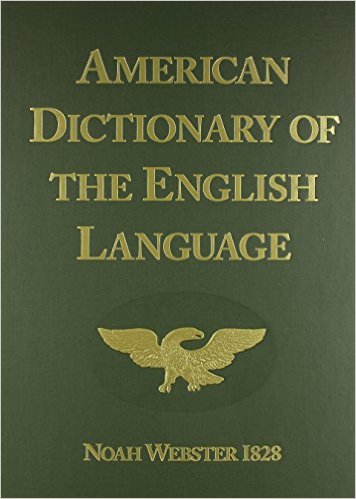 |
543 |
|
| Compact Edition |
353 |
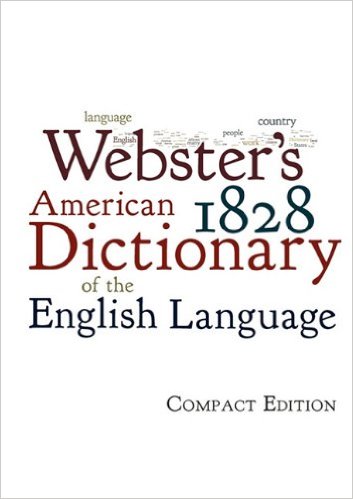 |
242 |
|
| CD-ROM |
303 |
 |
193 |
|
* As a note, I have purchased each of these products. In fact, as we have been developing the Project:: 1828 Reprint, I have purchased several of the bulky hard-cover dictionaries. My opinion is that the 2000-page hard-cover edition is the only good viable solution at this time. The compact edition was a bit disappointing and the CD-ROM as well. |
| [ + ] |
| Add Search To Your Site |
|
|
|
 1828.mshaffer.com › Word [angle]
1828.mshaffer.com › Word [angle]
